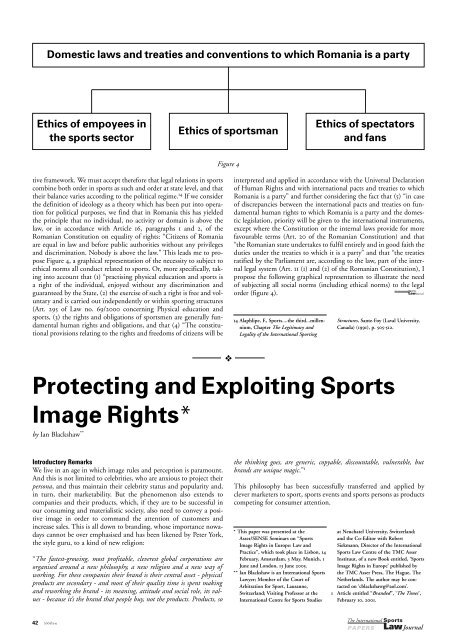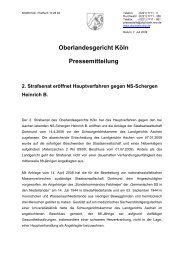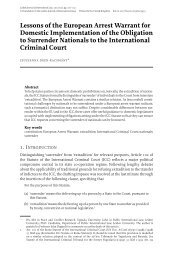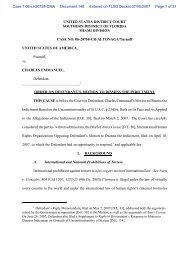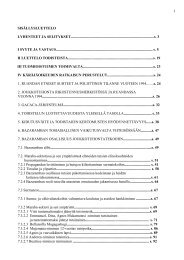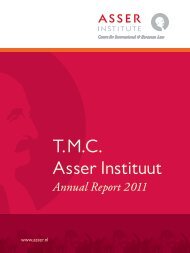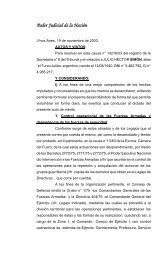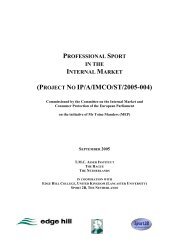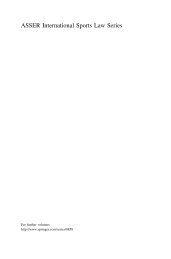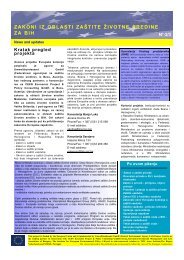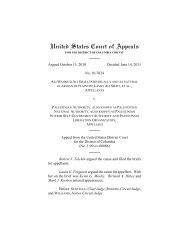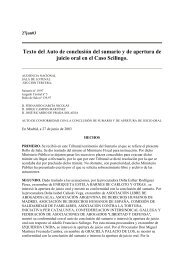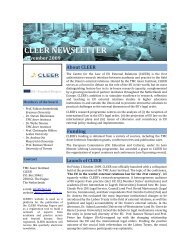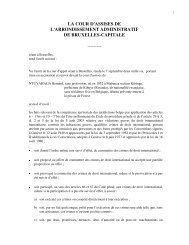The International Sports Law Journal 2005, No. 3-4 - Asser Institute
The International Sports Law Journal 2005, No. 3-4 - Asser Institute
The International Sports Law Journal 2005, No. 3-4 - Asser Institute
Create successful ePaper yourself
Turn your PDF publications into a flip-book with our unique Google optimized e-Paper software.
Domestic laws and treaties and conventions to which Romania is a party<br />
Ethics of empoyees in<br />
the sports sector<br />
Ethics of sportsman<br />
Ethics of spectators<br />
and fans<br />
Figure 4<br />
tive framework. We must accept therefore that legal relations in sports<br />
combine both order in sports as such and order at state level, and that<br />
their balance varies according to the political regime. 14 If we consider<br />
the definition of ideology as a theory which has been put into operation<br />
for political purposes, we find that in Romania this has yielded<br />
the principle that no individual, no activity or domain is above the<br />
law, or in accordance with Article 16, paragraphs 1 and 2, of the<br />
Romanian Constitution on equality of rights: “Citizens of Romania<br />
are equal in law and before public authorities without any privileges<br />
and discrimination. <strong>No</strong>body is above the law.” This leads me to propose<br />
Figure 4, a graphical representation of the necessity to subject to<br />
ethical norms all conduct related to sports. Or, more specifically, taking<br />
into account that (1) “practising physical education and sports is<br />
a right of the individual, enjoyed without any discrimination and<br />
guaranteed by the State, (2) the exercise of such a right is free and voluntary<br />
and is carried out independently or within sporting structures<br />
(Art. 295 of <strong>Law</strong> no. 69/2000 concerning Physical education and<br />
sports, (3) the rights and obligations of sportsmen are generally fundamental<br />
human rights and obligations, and that (4) “<strong>The</strong> constitutional<br />
provisions relating to the rights and freedoms of citizens will be<br />
interpreted and applied in accordance with the Universal Declaration<br />
of Human Rights and with international pacts and treaties to which<br />
Romania is a party” and further considering the fact that (5) “in case<br />
of discrepancies between the international pacts and treaties on fundamental<br />
human rights to which Romania is a party and the domestic<br />
legislation, priority will be given to the international instruments,<br />
except where the Constitution or the internal laws provide for more<br />
favourable terms (Art. 20 of the Romanian Constitution) and that<br />
“the Romanian state undertakes to fulfil entirely and in good faith the<br />
duties under the treaties to which it is a party” and that “the treaties<br />
ratified by the Parliament are, according to the law, part of the internal<br />
legal system (Art. 11 (1) and (2) of the Romanian Constitution), I<br />
propose the following graphical representation to illustrate the need<br />
of subjecting all social norms (including ethical norms) to the legal<br />
order (figure 4).<br />
14 Alaphlipe, F., <strong>Sports</strong>....the third...millennium,<br />
Chapter <strong>The</strong> Legitimacy and<br />
Legality of the <strong>International</strong> Sporting<br />
Structures, Sante-Foy (Laval University,<br />
Canada) (1991), p. 505-512.<br />
Protecting and Exploiting <strong>Sports</strong><br />
Image Rights*<br />
by Ian Blackshaw **<br />
❖<br />
Introductory Remarks<br />
We live in an age in which image rules and perception is paramount.<br />
And this is not limited to celebrities, who are anxious to project their<br />
persona, and thus maintain their celebrity status and popularity and,<br />
in turn, their marketability. But the phenomenon also extends to<br />
companies and their products, which, if they are to be successful in<br />
our consuming and materialistic society, also need to convey a positive<br />
image in order to command the attention of customers and<br />
increase sales. This is all down to branding, whose importance nowadays<br />
cannot be over emphasised and has been likened by Peter York,<br />
the style guru, to a kind of new religion:<br />
“<strong>The</strong> fastest-growing, most profitable, cleverest global corporations are<br />
organised around a new philosophy, a new religion and a new way of<br />
working. For these companies their brand is their central asset - physical<br />
products are secondary - and most of their quality time is spent making<br />
and reworking the brand - its meaning, attitude and social role, its values<br />
- because it’s the brand that people buy, not the products. Products, so<br />
the thinking goes, are generic, copyable, discountable, vulnerable, but<br />
brands are unique magic.” 1<br />
This philosophy has been successfully transferred and applied by<br />
clever marketers to sport, sports events and sports persons as products<br />
competing for consumer attention.<br />
* This paper was presented at the<br />
<strong>Asser</strong>/SENSE Seminars on “<strong>Sports</strong><br />
Image Rights in Europe: <strong>Law</strong> and<br />
Practice”, which took place in Lisbon, 14<br />
February, Amsterdam, 3 May, Munich, 1<br />
June and London, 13 June <strong>2005</strong>.<br />
** Ian Blackshaw is an <strong>International</strong> <strong>Sports</strong><br />
<strong>Law</strong>yer; Member of the Court of<br />
Arbitration for Sport, Lausanne,<br />
Switzerland; Visiting Professor at the<br />
<strong>International</strong> Centre for <strong>Sports</strong> Studies<br />
at Neuchatel University, Switzerland;<br />
and the Co-Editor with Robert<br />
Siekmann, Director of the <strong>International</strong><br />
<strong>Sports</strong> <strong>Law</strong> Centre of the TMC <strong>Asser</strong><br />
Instituut, of a new Book entitled, ‘<strong>Sports</strong><br />
Image Rights in Europe’ published by<br />
the TMC <strong>Asser</strong> Press, <strong>The</strong> Hague, <strong>The</strong><br />
Netherlands. <strong>The</strong> author may be contacted<br />
on ‘cblackshawg@aol.com’.<br />
1 Article entitled “Branded”, ‘<strong>The</strong> Times’,<br />
February 10, 2001.<br />
42 <strong>2005</strong>/3-4<br />
PAPERS


